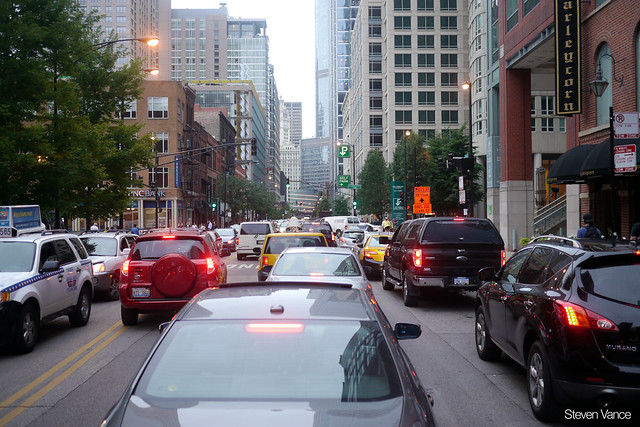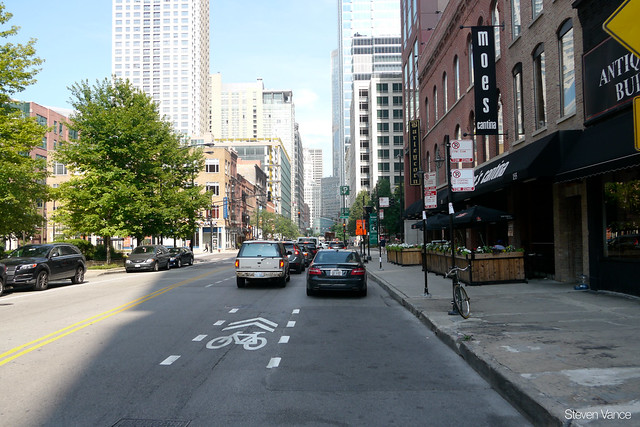Biking downtown has improved substantially with the addition of protected bike lanes on Kinzie Street and Dearborn Street, but much work remains to be done to create a safe, cohesive bike network linking people to Chicago's biggest employment center.
At last week's meeting of the Mayor's Bicycle Advisory Council, Michelle Stenzel, a community representative for the North Side, started the discussion about bikeways downtown. She began by noting that the Dearborn protected bike lane has been transformative. "I'm seeing so many more people biking downtown," she said, but mentioned how east-west access to her office on Michigan Avenue near Madison is difficult. "A lot of my coworkers commute from the train stations and say, 'I'd love to bike, but I'm afraid to bike in the Loop.'"
Luann Hamilton, deputy commissioner in the Chicago Department of Transportation, said that as part of the Central Loop Bus Rapid Transit project, protected bike lanes will be added to eastbound Washington Street and westbound Randolph Street, but not until December 2014. (The project will also create a two-way cycle track on southbound Clinton Street.) Commissioner Gabe Klein explained that IDOT "precluded us from doing Jackson through the Loop last year."
Stenzel then turned the discussion to going north out of the Loop. "We have Wells, but there's no good route back north, and I've tried everything," she said. Wells Street has a buffered bike lane from the Chicago River north to Lincoln Avenue, but is southbound only from Erie Street to the Chicago River. Then there's the two-way Dearborn cycle track, which ends just as it arrives on the north bank of the Chicago River. North of Kinzie Street, Stenzel said, "Dearborn is horrible."
So currently there is no buffered or protected bike lane northbound out of the Loop, from Kinzie Street to Erie Street, and Wells and Dearborn are three blocks apart with no continuous bike lane linking them.
The Chicago Department of Transportation did install new pavement markings on Kinzie between Wells and Dearborn this summer, consisting of sharrows and a block-long eastbound bike lane from LaSalle Street to Clark Street.
CDOT bikeways engineer Nathan Roseberry said more robust bikeway options on Kinzie were incompatible with existing left turn lanes, which the agency wants to keep for safety reasons. "Half of the distance there's either a left turn lane or a taper for a left turn lane," he said. "Because of all the short blocks, we looked at removing left turns and it wasn't feasible; they provide safety benefits. We needed to balance providing a safe street for bicyclists as well as pedestrians." He explained via email that "based on federal studies, left turn lanes have a 36 percent crash reduction factor for injury crashes. They improve visibility for left turns and provide space for left turning vehicles to exit a through lane."
Stenzel called those three blocks a "weak link," adding, "I have no problems biking on them as an experienced cyclist, but would I take a 10-year-old child on it with me? Probably not." That's the problem with using sharrows: Without dedicated space for bicycling, people who are "interested but concerned" about biking won't want to use the route.
This stretch of Kinzie has metered and unmetered curbside parking and loading and valet zones. Each block also has a large, off-street parking garage. I asked Roseberry about CDOT's parking study of this area. He said that CDOT looked at modifying parking and loading zones here but it wasn't possible to consolidate parking to one side. Additionally, Roseberry wrote, "Side streets did not provide an opportunity to relocate loading zones. Consolidating parking to one side or removing parking entirely would require elimination of loading zones which is not a viable option."
Roseberry said at the meeting that "we're looking at connecting Dearborn to Clark." Currently the Clark buffered bike lane ends at Oak Street and the left-side conventional bike lane on Dearborn ends before Walton, a one-block difference. Klein also mentioned that "there's an extension [coming] of the Dearborn bike lane north," meaning an improvement to existing conditions. He added that "this is something we're talking to the alderman [about] and we have to be careful what we say. We're looking at Dearborn, Clark. Something could happen this year."
CDOT's complete streets manager Janet Attarian mentioned Illinois and Grand, a pair of one-way streets with bike lanes that connect Wells and Dearborn. However, there's a gap of several blocks between these routes and the Dearborn protected bikeway, as well as short gap to the two-way section of Wells that could provide a safe northbound path out of the Loop.
Attarian added that a "ThinkBike workshop" will be held later in the year to involve the public and livable streets advocates in the redesign of Monroe Street in the Loop. A previous ThinkBike workshop, sponsored by the Netherlands government, was held in 2010 to come up with new designs for Randolph and Washington as well as a neighborhood-level bike plan for Lincoln Park.
Updated 22:56 to add comments about extending Dearborn protected bike lane and connecting Dearborn to Clark.







